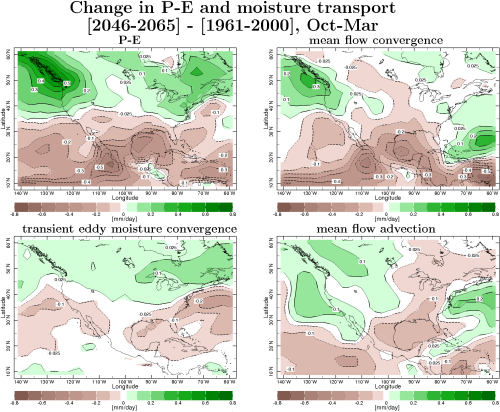|
Greenhouse warming and the 21st Century hydroclimate of southwestern North America
A new paper will soon appear in the Proceedings of the National Academy of Sciences (Seager and Vecchi, Greenhouse Warming and the 21st Century hydroclimate of Southwestern North America) that extends the work in our 2007 Science paper and web page. The PNAS paper, will be part of a special issue on southwest climate change but, until it appears, should not be quoted.
In this new paper we make some important advances on the 2007 paper:
-
We show the 1900 to 2100 simulated and projected (with the SResA1B emissions scenario) precipitation (P), evaporation (E) and P-E for all 24 models that participated in IPCC AR4 and for winter and summer half years separately. Maps of the multimodel mean change in P-E are also shown for the two half years. These make clear that the drying of southwest North America (SWNA) is driven by a reduction in winter P.
-
We consider whether the model projected drying is already occurring and conclude that the post 1979 drying is dominated by the influence of natural variability, particularly, in the tropical Pacific Ocean. In the three panel figure below we compare the observed
post-1979 trend in
precipitation from GPCP satellite-gauge data, the trend as computed from
a model forced by the observed SSTs from 1979 to 2007, and the IPCC
simulated (to 1999) and projected (after 2000) trend over the same period.
The SST-forced trend
is more akin to the impressive southwest drying that has occurred than
is the IPCC estimate of the radiatively forced trend. Since the observed
SST trend since 1979 has been to a more La Niña-like trend, which we
associate with Pacific decadal variability, we conclude that most of the
drying over recent decades has been of natural origin.
This emphasizes that near term hydroclimate projection for SWNA needs to account for natural decadal variability and radiatively forced change. It also suggests that SWNA is in a natural drier-than-normal regime which is being added to by anthropogenic drying.

-
A multimodel analysis of the winter half year vertically-integrated moisture budget is performed
to show that drying (top left) occurs because of increasing moisture
divergence by the mean flow (top right) and, to a lesser extent, by
reduced moisture convergence by transient eddies (bottom left).
The increased mean flow divergence arises in large part from increased
humidity in a divergent mean flow analagous to the mechanism
of Held and Soden (2006).
-
The IPCC AR4 models are also separated into those that show an increase in the equatorial east-west SST gradient of more than 0.1K (6 models) and those that show a
decrease of more than 0.1K (6 models). The former, which have some
characteristics of a La Niña-like response of tropical Pacific climate to
increasing radiative forcing, have more extreme reductions of P-E over SWNA than
does the 'El Niño-like' set. This shows that, even amidst a strong overall warming,
small changes in SST gradient will impact SWNA climate change, just as small changes in
gradients forced the historical droughts, see our web pages
on the causes of twentieth century and nineteenth century droughts.
Alas, we have no confidence as to whether the real tropical Pacific Ocean will have a stronger or weaker east-west SST gradient in the current century because of the poor quality of the models' simulation of tropical Pacific climate. However over the 20th century the east-west SST gradient strengthened, see Karnauskas et al. (2009).

-
We also briefly review the current research on changes in snowpack and timing of melt and the potential for ecosystem feedbacks to modify hydroclimate change in SWNA concluding that it appears that, in sum, these will add to the West's water woes caused by reducing winter precipitation.
We did not address the issue of what will happen to the North American monsoon (NAM) partly because Gabe Vecchi and I have not worked on that (yet), the lack of prior work on how it will respond to climate change and questions as to whether it is modeled well in global models. However, at least for most of SWNA within the U.S., it is winter precipitation that matters most for water resources (e.g. over the Sierra Nevada and Rockies). The NAM will have to be addressed another day!
REFERENCES
-
Seager, R. and Vecchi, G.A., 2010: Greenhouse warming and the 21st Century hydroclimate of southwestern North America, Proceedings of the National Academy of Sciences, in press.
PDF
-
Karnauskas KB, Seager R, Kaplan A, Kushnir Y, Cane MA, 2009: Observed strengthening
of the zonal sea surface temperature gradient across the equatorial Pacific Ocean, Journal
of Climate, 22, 4316-4321.
PDF
-
Seager, R., M.F. Ting, I.M. Held, Y. Kushnir, J. Lu, G. Vecchi, H.-P. Huang, N. Harnik, A.
Leetmaa, N.-C. Lau, C. Li, J. Velez, N. Naik, 2007: Model Projections of an Imminent
Transition to a More Arid Climate in Southwestern North America, Science, 316, (5828),
1181-1184 DOI: 10.1126/science.1139601.
PDF
|

|






